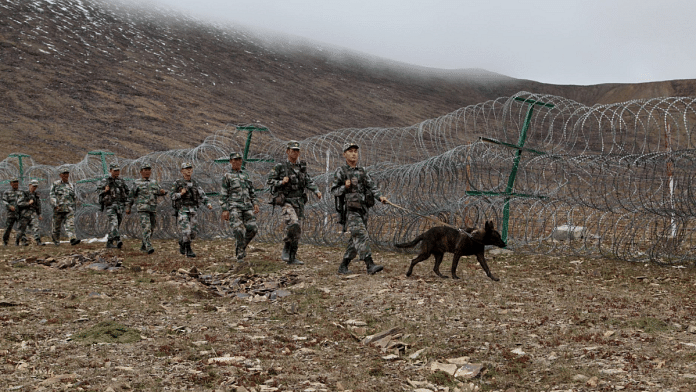New Delhi: China and Bhutan have decided to fast-track the demarcation of their disputed border, a development that could have a strategic impact on India’s interests. This is because one of the areas under discussion is Doklam — the plateau where the Indian and Chinese armies had a tense standoff in 2017.
China claims around 764 sq km of land in northwestern and central Bhutan, in a dispute that dates to the Chinese occupation of Tibet in the 1950s. The two countries have conducted 24 rounds of talks on the issue, as well as 13 Expert Group Meetings (EGM) — three of which have been held this year.
At the 13th EGM held in Beijing between 21 and 24 August, the two countries established a joint technical group on the delimitation of the borders, and this group held its first meeting on the sidelines of the EGM.
According to a joint statement, China and Bhutan also concurred that they should proceed quickly and implement a “Three-Step Roadmap” agreed earlier for expediting the boundary negotiations in phases.
ThePrint explains the history of the border dispute, its strategic relevance for India and the progress of the talks thus far.
Also Read: India, China talks fail to make headway on Depsang but both sides agree to freeze build-up
Origins of the dispute & importance of Doklam
China and Bhutan share a roughly 477-km border. The boundary dispute originated when China occupied Tibet in 1950 and refused to recognise the dividing line between Tibet and Bhutan. Until then, this had been determined by the ‘highest watershed principle’, used to demarcate international borders in mountainous areas.
During its 1959 military campaign in response to the Tibetan uprising, China also seized control over eight Bhutanese enclaves in Tibet.
Since then, negotiations between Thimphu and Beijing have focussed only on three areas of contention — the Jakarlung and Pasamlung areas in north Bhutan, as well as the more well-known Doklam area in west Bhutan.
However, in 2020, Beijing unexpectedly asserted ownership of the Sakteng Wildlife Sanctuary, which is located in eastern Bhutan and borders Arunachal Pradesh.
The point of concern for India is Doklam. India considers the Doklam plateau to be an undisputed part of Bhutanese territory, but China considers it an extension of its Chumbi Valley — the wedge of land that lies between Sikkim and Bhutan.
It overlooks the strategically important Siliguri Corridor, which is the gateway to India’s Northeast, besides linking India with Tibet, Nepal, Bhutan, and Bangladesh. The plateau has an area of approximately 89 sq km, with a width of less than 10 km.
While China claims much more territory in the northern part of Bhutan, the strategic significance of Doklam is what makes it important for Beijing.
Over the years, China captured small pieces of territory in Doklam, and in 2017, it started constructing a road towards the strategically important Jampheri ridge-line.
But on 18 June, 2017, Indian soldiers stepped in to form a human wall to prevent Chinese earth excavators and workers from carrying out construction activities. The standoff, which went on for more than two months, led to increased regional tensions and was closely monitored by global powers.
It finally ended with China agreeing not to construct the road and moving back by 200 metres, while India moved back to the Dokala Post that it has maintained for the last several years.
As reported by ThePrint in 2019, the Chinese have carried out extensive construction on the Bhutanese territory and the Indian concern is that China could simply take over Doklam as part of the boundary talks with Bhutan.
India believes that China claiming rights over the Sakteng Wildlife Sanctuary is part of its strategy to pressure Bhutan and take over Doklam.
Earlier this year, Bhutanese Prime Minister Lotay Tshering in an interview with a Belgian daily reportedly said, “Doklam is a junction point between India, China, and Bhutan. It is not up to Bhutan alone to solve the problem.”
China-Bhutan negotiations
According to a statement issued by Bhutan’s foreign ministry in 2014, Bhutan and China held their first round of border negotiations in 1984.
The two countries went on sign two agreements in 1988 and 1998 — respectively, the Guiding Principles on the Settlement of the Boundary Issues and the Agreement on Maintenance of Peace and Tranquility along the Border Areas.
Subsequent negotiations have been based on these agreements, which focus on maintaining peace at the border and maintaining the pre-1959 boundary status quo.
Starting with the seventh round of talks in 1990, China persisted in promoting a “package proposal”, wherein it would give up its 495 sq km of northern claims in return for Bhutan recognising its western claims, which included Doklam. This proposal was, however, rejected by Bhutan’s National Assembly, and subsequent sessions of the assembly also indicated opposition to any kind of an exchange.
At the 24th round of talks, held in Beijing in 2016, it was announced that important progress had been made and that the two sides had jointly completed surveying the disputed areas.
The 12th EGM was held in May this year. Despite the objectives stated at this meeting — which included increasing the frequency of meetings — the 25th round of border negotiations is yet to take place.
(Edited by Richa Mishra)
Also Read: More Galwan clash videos leaked before June anniversary. Beijing or Islamabad is behind this



